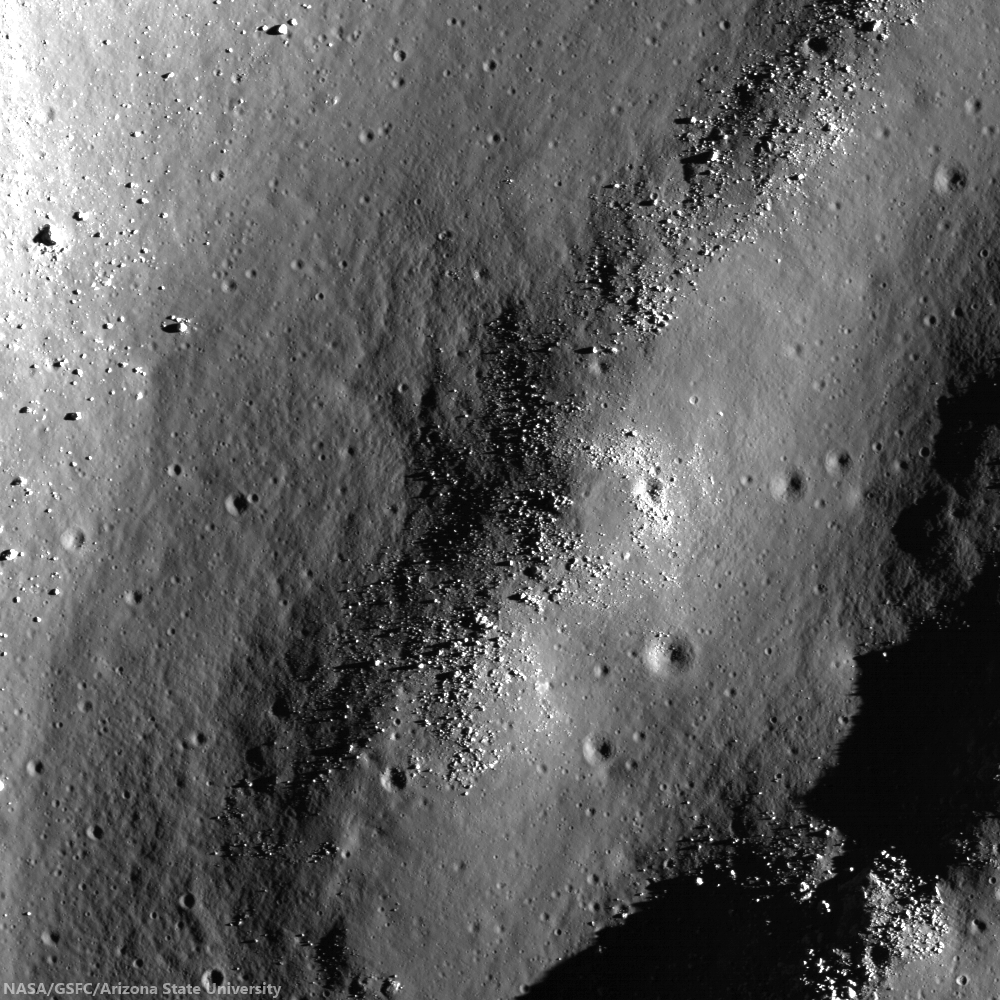 |
| An approximately 1 km-wide field of view showing boulders strewn across the wall and floor fracture in Humboldt crater. LROC Narrow Angle Camera (NAC) observation M146466012R, LRO orbit 6718, December 8, 2010; angle of incidence 71.68° at 94 cm per pixel resolution from 45.14 km over 24.87°S, 79.03°E. [NASA/GSFC/Arizona State University]. |
H. Meyer
LROC News System
Many lunar craters contain floor fractures and evidence for volcanic activity. In the case of (the LROC) Featured Image (released December 23, 2013), the fracture seen eroding to boulders formed in the large impact crater Humboldt, whose floor has been partially covered by dark mantle material (possibly pyroclastic in origin) and lava flows.
There are a few possibilities for the formation of these floor fractures. The two most common are viscous relaxation and intrusive magmatic activity, though intrusive magmatic activity is currently the favored model.
The lava flows, some of which can be seen in the WAC context images above, are limited to only a few small areas within Humboldt and only partially fill some fractures, so they were probably not extruded during the formation of the fractures. If they had been emplaced during the formation of the fractures, then we would expect to see lava flows everywhere there are fractures, which is not the case. However, the intrusion of the magma into the subsurface of the crater floor (that eventually erupted onto the surface) could have contributed to the formation of the fractures by causing the floor to dome up.
View the full processed LROC NAC observation, HERE.
Related LROC Posts:
Karpinskiy Floor Fractures (August 22, 2013)
"Star light, star bright" (May 29, 2013)
Numerov's Graben (February 14, 2013)
A small crater's disappearing floor (November 4, 2011)
Last Portion of the Original Floor (November 3, 2011)
Pull Apart Grabens (December 16, 2009)
LROC News System
Many lunar craters contain floor fractures and evidence for volcanic activity. In the case of (the LROC) Featured Image (released December 23, 2013), the fracture seen eroding to boulders formed in the large impact crater Humboldt, whose floor has been partially covered by dark mantle material (possibly pyroclastic in origin) and lava flows.
There are a few possibilities for the formation of these floor fractures. The two most common are viscous relaxation and intrusive magmatic activity, though intrusive magmatic activity is currently the favored model.
 |
| Roughly 39 km-wide field of view as context for the more detailed view of erosion and floor fractures on the northwest floor of Humboldt crater (199 km, 27.02°S, 80.96°E). Red rectangle outlines field of view swept up in LROC NAC M146466012RE and the yellow box designates the area withing the LROC Featured Image released December 23, 2013, LROC monochrome (604 nm) Wide Angle Camera (WAC) observation M161787569CE, LRO orbit 8976, November 6, 2011; angle of incidence 70.87° at 67.16 meters per pixel resolution from 47.6 km [NASA/GSFC/Arizona State University]. |
 |
| Further context of western Humboldt crater, a 103 km-wide area, from a stitching together of three LROC WAC observations, including LROC WAC observations swept up in orbits immediately before and after on November 6, 2011. View the full-sized original mosaic HERE. [NASA/GSFC/Arizona State University]. |
 |
| LROC WAC mosaic, showing Humboldt crater and its immediate vicinity, with a false-color overlay representing the LROC photography-based digital terrain model (DTM) at 250 meter resolution through the LROC QuickMap web-based application [NASA/GSFC/Arizona State University]. |
View the full processed LROC NAC observation, HERE.
Related LROC Posts:
Karpinskiy Floor Fractures (August 22, 2013)
"Star light, star bright" (May 29, 2013)
Numerov's Graben (February 14, 2013)
A small crater's disappearing floor (November 4, 2011)
Last Portion of the Original Floor (November 3, 2011)
Pull Apart Grabens (December 16, 2009)


No comments:
Post a Comment